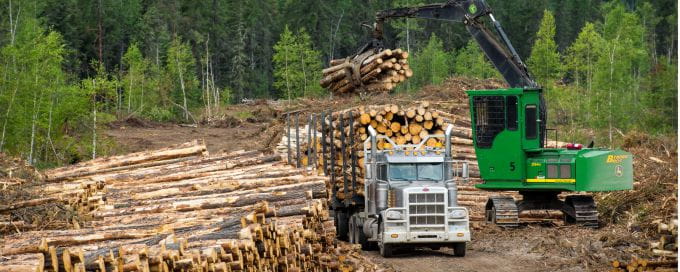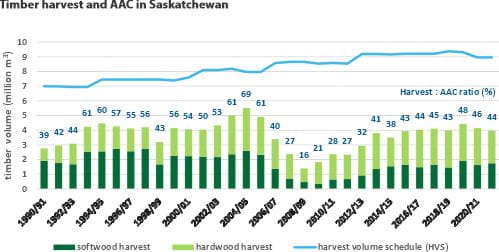
Why we measure this
Healthy forests provide benefits such as clean air, fresh water, wildlife habitat and materials for building homes. A key forest management consideration is how forests change over time – young trees grow to maturity, decline and eventually die. Throughout this lifecycle a forest may be harvested for wood products, burned in wildfires or continue growing until it becomes old and falls over or is killed by insects and diseases.
Forest management plans are one tool used by professional foresters to care for our forests. When trees are harvested according to these plans, the harvest levels will be sustainable and the forests and the benefits they provide will continue. In Saskatchewan's managed forests, the growth rate exceeds the rate of harvest. This means that some areas will age past maturity and more harvesting may be necessary to keep the forest healthy.
What is happening

For each timber supply area in the commercial forest and fringe forest (Crown agriculture) zones, an annual allowable cut (AAC) is calculated. The AAC is determined from computer modelling and analysis of forests over a 200-year period. To ensure sustainable forest management, the amount of harvest must not exceed the AAC over a specified term. Harvesting on private and federal lands is not regulated in Saskatchewan, but for the purpose of this indicator, timber harvested from private and federal lands have been included and the AAC have been estimated.
Comparing the AAC to the realized annual harvest is a key performance indicator of sustainable forest management. The comparison provides information on the over or under-utilization of wood supply and how the forestry industry is performing relative to its allocation of timber. Additionally, it may highlight potential investment opportunities for Saskatchewan's forestry sector. A higher utilization percentage of realized annual harvest to AAC may indicate that the forest industry is performing well, whereas a low utilization percentage may indicate a downturn.
The low realized annual harvest to AAC utilization percentages observed between 2006 and 2009 in Saskatchewan's commercial forest zone coincide with a period of global economic recession. Since then, as the forest industry recovers, the utilization percentage of realized annual harvest to AAC has increased and stabilized. However, the utilization percentage has not returned to pre-recession levels. In 2021-22, of the 8.95 million cubic metre provincial AAC, 3.97 million cubic metres of timber were harvested. This represents a 44 per cent harvest to AAC utilization percentage. As a consequence of not achieving a higher per cent harvest to AAC utilization percentage, Saskatchewan's forests may age past healthy maturity and be more susceptible to natural disturbances, such as wildfires, insects and disease.

What we are doing
Overharvesting is not permitted in our Saskatchewan forests. Harvest allocation holders are required to ensure their harvest levels do not exceed the sustainable AAC for their harvest area.
Annual harvest levels are further tracked and verified by the Ministry of Environment. This indicator is intended to provide stakeholders with evidence that the harvest at the provincial scale is being conducted in alignment with the principles of sustainable forest management.
For more information on the forest sector in Saskatchewan, visit saskatchewan.ca/forestry.



